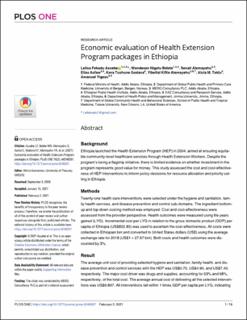| dc.contributor.author | Assebe, Lelisa Fekadu | |
| dc.contributor.author | Belete, Wondesen Nigatu | |
| dc.contributor.author | Alemayehu, Senait | |
| dc.contributor.author | Asfaw, Elias | |
| dc.contributor.author | Godana, Kora Tushune | |
| dc.contributor.author | Alemayehu, Yibeltal Kiflie | |
| dc.contributor.author | Teklu, Alula M. | |
| dc.contributor.author | Yigezu, Amanuel | |
| dc.date.accessioned | 2022-02-07T13:53:55Z | |
| dc.date.available | 2022-02-07T13:53:55Z | |
| dc.date.created | 2022-01-18T09:05:47Z | |
| dc.date.issued | 2021 | |
| dc.identifier.issn | 1932-6203 | |
| dc.identifier.uri | https://hdl.handle.net/11250/2977543 | |
| dc.description.abstract | Background
Ethiopia launched the Health Extension Program (HEP) in 2004, aimed at ensuring equitable community-level healthcare services through Health Extension Workers. Despite the program’s being a flagship initiative, there is limited evidence on whether investment in the program represents good value for money. This study assessed the cost and cost-effectiveness of HEP interventions to inform policy decisions for resource allocation and priority setting in Ethiopia.
Methods
Twenty-one health care interventions were selected under the hygiene and sanitation, family health services, and disease prevention and control sub-domains. The ingredient bottom-up and top-down costing method was employed. Cost and cost-effectiveness were assessed from the provider perspective. Health outcomes were measured using life years gained (LYG). Incremental cost per LYG in relation to the gross domestic product (GDP) per capita of Ethiopia (US$852.80) was used to ascertain the cost-effectiveness. All costs were collected in Ethiopian birr and converted to United States dollars (US$) using the average exchange rate for 2018 (US$1 = 27.67 birr). Both costs and health outcomes were discounted by 3%.
Result
The average unit cost of providing selected hygiene and sanitation, family health, and disease prevention and control services with the HEP was US$0.70, US$4.90, and US$7.40, respectively. The major cost driver was drugs and supplies, accounting for 53% and 68%, respectively, of the total cost. The average annual cost of delivering all the selected interventions was US$9,897. All interventions fall within 1 times GDP per capita per LYG, indicating that they are very cost-effective (ranges: US$22–$295 per LYG). Overall, the HEP is cost-effective by investing US$77.40 for every LYG.
Conclusion
The unit cost estimates of HEP interventions are crucial for priority-setting, resource mobilization, and program planning. This study found that the program is very cost-effective in delivering community health services. | en_US |
| dc.language.iso | eng | en_US |
| dc.publisher | Public Library of Science | en_US |
| dc.rights | Navngivelse 4.0 Internasjonal | * |
| dc.rights.uri | http://creativecommons.org/licenses/by/4.0/deed.no | * |
| dc.title | Economic evaluation of Health Extension Program packages in Ethiopia | en_US |
| dc.type | Journal article | en_US |
| dc.type | Peer reviewed | en_US |
| dc.description.version | publishedVersion | en_US |
| dc.rights.holder | Copyright 2021 Assebe et al | en_US |
| dc.source.articlenumber | e0246207 | en_US |
| cristin.ispublished | true | |
| cristin.fulltext | original | |
| cristin.qualitycode | 1 | |
| dc.identifier.doi | 10.1371/journal.pone.0246207 | |
| dc.identifier.cristin | 1983144 | |
| dc.source.journal | PLOS ONE | en_US |
| dc.identifier.citation | PLOS ONE. 2021, 16 (2), e0246207. | en_US |
| dc.source.volume | 16 | en_US |
| dc.source.issue | 2 | en_US |

